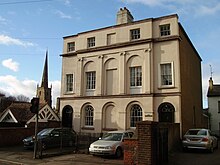George Vaughan Maddox
| George Vaughan Maddox | |
|---|---|

Kingsley House (left), built to Maddox's design and his home for much of his life
|
|
| Born | 1802 Monmouth |
| Died | 27 February 1864 (age 61/62) Hempsted, Gloucestershire |
| Residence |
8 Monk Street, Monmouth Pentwyn, Rockfield |
| Occupation | Architect |
| Years active | 1820s–1840s |
George Vaughan Maddox (1802–27 February 1864) was a nineteenth-century British architect and builder, whose work was undertaken principally in the town of Monmouth, Wales, and in the wider county. Working mainly in a Neo-Classical style, his extensive output made a significant contribution to the Monmouth townscape. The architectural historian John Newman writes that his buildings "give(.) Monmouth its particular architectural flavour. For two decades from the mid-1820s he put up a sequence of public buildings and private houses in the town, in a style deft, cultured, and only occasionally unresolved." The Market Hall and 1-6 Priory Street are considered Maddox's "most important projects".
Maddox was born in 1802, the son of another architect, John Maddox, who also worked in the county. Maddox designed some of Monmouth's most notable buildings, including the Market Hall, "his major work",the Beaufort Arms Hotel, the Methodist Church, the Masonic Hall, Kingsley House, Oak House, and 18 St James Street,.
For much of his life, Maddox lived at 8 Monk Street, Monmouth. In the early 1830s, Maddox won a competition organised by the Borough Council in Monmouth, to design a new scheme which would relieve Church Street of through traffic, and provide new accommodation for slaughterhouses and a new Market Hall to replace the market beneath the Shire Hall which faced disruption because of the need to extend the accommodation for the Assizes. Maddox proposed a new carriage road running above the bank of the River Monnow, supported by a viaduct. The Market Hall, with a crescent-shaped frontage of Bath Stone in a Doric style, and an Ionic cupola and clerestory above the central part of the building, was built on one side of the road, and a long convex stuccoed frontage, 1-6 Priory Street, on the opposite side. The new slaughterhouses, comprising 24 rooms with openings onto the river so that their waste would drain directly into it, were sited beneath the sandstone arches of the viaduct. The new road – now Priory Street – was opened in 1834, and the Market Hall in 1840.
...
Wikipedia
